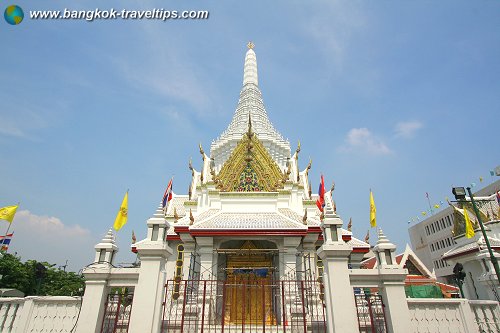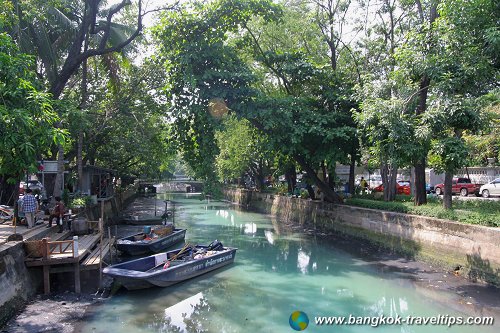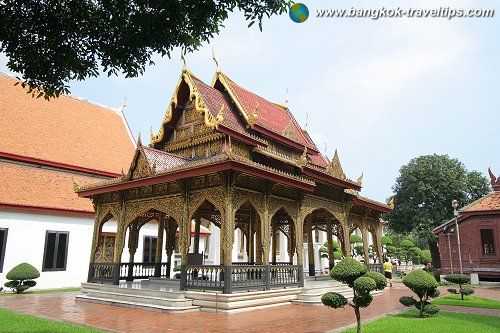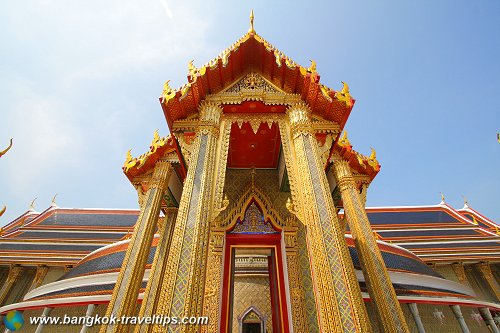Rattanakosin is the oldest and most historical district of Bangkok, established by King Rama I in 1782. It became the new capital of Siam because the old capital, Ayutthaya, burned to the ground. To tell you more, let me take you back in time, from when Rattanakosin was first made capital of Siam, to Rattanakosin as part of modern-day Thailand.
The decades-long conflict between Siam and Burmese finally culminated with a major offensive by the Burmese, who in 1767 surrounded the island where Ayutthaya was built, and after fierce fighting, burned and destroyed all the buildings in Ayutthaya to prevent further insurrection by the Siamese.
 Buddha statue in Wat Mahathat (29 August 2006)
Buddha statue in Wat Mahathat (29 August 2006)
The Siamese would have been totally annihilated if not for a Siamese general of Chinese Teochew extraction, Taksin, who with a team of men managed to elude the Burmese (how they managed to do that still baffled historians today), escaped from Ayutthaya. Seven months after the fall of Ayutthaya, Taksin ejected the Burmese from Ayutthaya at the Pho Sam Ton camp, but the city was beyond recovery. Taksin then established a new Siamese capital at Thonburi, on the west bank of the Chao Phraya River across from where Rattanakosin is located, and had himself crowned the new king of Siam.
Under King Taksin, Siam grew even bigger than its size when its old capital at Ayutthaya fell. Having ousted the Burmese, he brought the whole of the Chao Phraya basin under his rule. In 1769, he occupied western Cambodia. Then he moved south to re-establish Siamese rule over much of the Malay Peninsula, as far as what is now Penang on the west coast, and Terengganu on the east. In 1774, through his general Chao Phraya Chakri, he pushed north and wrestled Chiang Mai from the Burmese. Chao Phraya Chakri then led the Siamese army to capture Vientiane, putting Laos under Siamese dominion.
 Lak Muang (29 August 2006)
Lak Muang (29 August 2006)
But even with all the successes, the people found that their king was becoming increasingly neurotic. He demanded that he be worshipped as a god - to be precise, he claimed to be Sotapanna, meaning, having reached the first of the four stages of Buddhist enlightenment. Such a claim alienated him from the monkhood. Despite being half-Chinese, he discriminated against the Chinese merchants. Believing that his own wife and sons were plotting against him, he imprisoned and tortured them.
King Taksin's reign ended after 15 years, when he was removed from the throne in what may have been a coup d'etat. He met a fate similar to that of King Ludwig of Neuschwanstein Castle fame: they declared him insane. But while Ludwig drowned in a lake, Taksin was executed.To prevent royal blood from touching the ground, his executioners threw him into a velvet sack and clobbered him to death with a scented sandalwood club. That's the general view of how he met his end, although there was also a popular rumor that Taksin never died that way. In a tale reminiscent of the Muslim version of Jesus, a substitute replaced Taksin in the sack, and he was secreted away, to spend the remainder of his life in rural Nakhon Si Thammarat, where he lived to a ripe old age of 91 (dying in 1825). I personally find this tale unlikely, and believe that he was indeed given the sack, literally. Today, Thais look back on his reign with respect, and appreciate what he had done. For that reason, he is officially titled King Taksin the Great.
 Sanam Luang (28 October 2006)
Sanam Luang (28 October 2006)
When King Taksin was disposed, Chao Phraya Chakri was away fighting in Cambodia. He hurried back to Thonburi upon learning the news. The coup plotters surrendered to him, and offered him the throne of Siam. That was how General Chao Phraya Chakri became the new king and from him began the Chakri Dynasty that continues to this day. We know him today as King Rama I, although the use of Rama with roman numerals only came about much later; the numbering started with Rama III while "Rama" itself started with King Rama VI, who was the only Chakri king to title himself Rama VI, presumably influenced European way of numbering their rulers.
General Chao Phraya Chakri, who became King Rama I, was born Thong Duang in 1736. His father was Keeper of the Ruler's Seal, and a descendent of Kosa Pan, a Siamese diplomat in France. Like Taksin, General Chao Phraya Chakri had Chinese blood in him, on his mother's side. He ascended the throne as King Ramathibodi, and posthumously as Phra Buddha Yodfa Chulaloke.
 Standing Buddhas, cloister of Wat Pho (28 October 2006)
Standing Buddhas, cloister of Wat Pho (28 October 2006)
One of the first things King Rama I did was to move the capital. From Thonburi across the river to Rattanakosin. For that to happen, the Chinese already settled there had to get out of the way. They relocated further downstream, in a place that continues to this day as Bangkok's Chinatown.
At the astrologically determined auspicious hour of 6:54 am on 21 April, 1782, a pillar containing the ruler's hopes and aspirations for the city was driven into the ground, marking the founding date of Krung Rattanakosin. That pillar is today housed in the City Pillar Shrine, also called Lak Muang. King Rama I gave the place the name Krung Thep Phra Maha Nakhorn, which means City of Angels, the Capital City. This is shortened to be Krung Thep, the name that the Thais call Bangkok. Under King Mongkut, the ceremonial name of Bangkok was further stretched to become Krung Thep Mahanakhon Amon Rattanakosin Mahinthara Yuthaya Mahadilok Phop Noppharat Ratchathani Burirom Udomratchaniwet Mahasathan Amon Piman Awatan Sathit Sakkathattiya Witsanukam Prasit. As you would expect, it's all full of ostentatious exhortations, in a mix of Sanskrit and Pali; in English, it reads as "The city of angels, the great city, the eternal jewel city, the impregnable city of God Indra, the grand capital of the world endowed with nine precious gems, the happy city, abounding in an enormous Royal Palace that resembles the heavenly abode where reigns the reincarnated god, a city given by Indra and built by Vishnukam".
 Boats on Khlong Lord (29 August 2006)
Boats on Khlong Lord (29 August 2006)
From Rattanakosin, Krung Thep was to spread, to eventually cover both sides of the Chao Phraya River. Foreigners, however, refer to the Thai capital after the name of the district on the west bank of the Chao Phraya, which is called Bangkok. So the name "Bangkok" means a different place, in Thai and in English. To the Thais, it is just a small area in Thonburi, to the English speaking, it encompasses what is Krung Thep.
To beef up the defences of Krung Thep, King Rama I turned Rattanakosin into an island. As it is located on a curve of the meandering Chao Phraya River, he dug two defensive rings of canals to protect his capital, and fortified them with fortresses. Sumen Fort and Mahakan Fort are the only two remaining canal fortresses out of the original fourteen that were built. These canal rings, which you can see in the map I attach on this page, still exist today. The inner one is Khlong Lord, part of which has been filled up. The outer one comprises Khlong Banglamphu and Khlong Ong Ang. Later on, the third ring canal, Khlong Phadung Krungkasem, was added. Additional canals were added, both on the east as well as west sides of the Chao Phraya. Until Charoen Krung Road was paved in 1861, the majority of Bangkok's population lived a semi-amphibious life, in huts on rafts or on stilts. Only Rattanakosin was permanently dry.

Pavilion in the National Museum (28 October 2006)

The Grand Palace and Wat Phra Kaew (Temple of the Emerald Buddha) were constructed shortly after the capital was established. The Emerald Buddha, which is believed to have been created in India in 43 BC, travelled to Sri Lanka three hundred years later, then to Cambodia in 457 AD (though it was intended for Myanmar), to Ayutthaya in 1434 following the capture of Angkor Wat, to Chiang Saen a hundred years later, to Chiang Rai, then to Lamphang until 1468, to Chiang Mai until 1552, to Luang Prabang until 1564, to Vientiane until 1779, and finally to Thonburi until 22 March, 1784, when it was installed at Wat Phra Kaew, in Rattanakosin, where it stays to this day.
Around the Grand Palace, King Rama I built other government administrative buildings. Other palaces and gardens were added to Rattanakosin. Wat Po was expanded and renamed Wat Phra Chetuphon. Under King Rama III, the Chapel of the Reclining Buddha was built. Rattanakosin was the nerve center of Bangkok until King Chulalongkorn, who built the palaces in Dusit, to excape the congestion of 19th century Rattanakosin.

Phra Vihara Thit, Wat Ratchanaddaram (29 August 2006)

Today Rattanakosin is regarded as the most historical part of Bangkok and is where you can find a huge concentration of notesworthy sights. To properly explore all the sights in this area, you would need a full day, or even two.

Reclining Buddha in full, from top (28 October 2006)

Sights in Rattanakosin
Sights arranged in alphabetical order:List of Neighbourhoods in Bangkok; list of Districts of Bangkok
 Latest updates on Penang Travel Tips
Latest updates on Penang Travel Tips
 Map of Roads in Penang
Map of Roads in Penang
Looking for information on Penang? Use this Map of Roads in Penang to zoom in on information about Penang, brought to you road by road.
Copyright © 2003-2025 Timothy Tye. All Rights Reserved.

 Go Back
Go Back